When you first start following the game of cricket, you may hear the term “Wicket” in cricket several times. It is used by the commentators, avid audiences, and even cricketers alike! So much so, that it may make your wonder what exactly does this term mean, and when is it used? I know I get asked about this often by novice followers. In this article, we help you understand everything about it!
So, what is a wicket in cricket? A “Wicket” is a set of three wooden sticks perpendicular to the ground known as stumps along with two small wooden pieces resting on top of them known as bails. In cricket, there are two sets of wickets rooted on both sides of the pitch.

In other words, a set of 3 stumps and 2 bails put together forms a wicket. While that is the primary meaning of a wicket, the term is also often used to represent other elements within the game. Let’s look at when and where else is the term used.
Some Other Meanings of the Term “Wicket” and How it is Used
As mentioned before, the term “Wicket” is used on several occasions in the game of Cricket, and it can have different meanings based on the context it is used in.
1. The Pitch
One of the other most common usage of the term wicket in cricket is to represent the cricket pitch itself. In order words, the area across the 22 yards between the two sets of wickets.
Although the usage of the term wicket to represent the pitch is incorrect as per the laws of cricket. However, over the years, due to the common usage by the commentators and the evolution of television and sports broadcasting, this meaning of the term has become more common amongst fans and followers.
You may hear the terms “Sticky Wicket” or “Dry Wicket” used by the commentators. This is used in order to represent the nature and possible behavior of the cricket pitch.
2. Dismissal of a Batsman (Losing a Wicket)
Another usage of the term Wicket in the game of Cricket is when a Batsman gets dismissed. For the batting team, this phenomenon may also be known as “Losing a Wicket“.
As you may be aware, the goal of the batsman is to protect his wickets when a bowler delivers a ball. In doing so, the batsman has to try and score as many runs as possible. The goal of the bowling team is to dismiss a batsman and send him back to the pavilion. When this does happen, the bowling team will have taken a wicket whereas a batting team is known to lose a wicket.
Another common usage is “Number of Wickets lost by the batting team“. Every time a batting team loses a wicket, it impacts the score of the team. For e.g. a score of 50/0 means the batting team has scored 50 runs and lost 0 wickets. In other words, 0 batsmen from the batting team have been dismissed. Likewise, a score of 200/5 means that the batting team has scored 200 runs and 5 batsmen have been dismissed.
The term “Wickets taken” is also used in the game of cricket. This is to represent the number of batsmen that have been dismissed by either a bowling side or a particular bowler. This is very helpful in analysing the performance of a bowler. For e.g. bowling stats of 5/25 (read as 5 for 25) means that a bowler has taken 5 wickets (dismissed 5 batsmen) and given away or conceded 25 runs.
It is important to note – in this process of taking and losing a wicket, the actual wickets (the set of 3 stumps and 2 bails) are not lost or taken away by the players. The term is only used as a representation for the dismissal of a batsman.
3. Partnership for a Wicket (1st, 2nd …10th Wicket Partnership)
Another common usage of the term “Wicket” is to represent the partnership by a set of batsmen. Although the partnership is measured in the number of runs scored, however, the term “Partnership for a Wicket” is used identify which wicket for which the partnership is being measured. This can further explained using an example as done below –
When you hear the term “2nd Wicket Partnership“, it would mean the number of runs that were scored by the two batsmen together after the 1st wicket was lost by the batting team. In such a scenario, the partnership for the 2nd wicket will start immediately after the first batsman is dismissed.
For e.g. if Team A is batting and they lose their 1st wicket at the score of 55 (55/1). However, they lose their 2nd wicket at the score of 155 (the score thus reads 155/2). Thus, the partnership for the 2nd wicket would be 155-55 = 100 runs.
Similarly, you may see a partnership chart during a match that showcases the runs scored by the two batsmen for each wicket is represented as 1st wicket partnership, 2nd wicket partnership and so on..)
4. Match Outcome (Winning a match by Wickets)
Another common usage of the term “Wicket” that you may come across is while representing the outcome of the match. You may often notice that the result is indicated as “Team B won the match by 4 wickets“.
As long as the match ends with one of the two teams winning it, the outcome can be represented as either the team won by X number of runs or the team won by X number of wickets. This may vary based on whether the team batting first won the match or if the team batting second won the match. If the team batting second wins the match, the victory margin is denoted by the match won by the number of Wickets left.
This scenario can be better understood with an example. If the Team A bats first and scored 200 runs and set a target of 201 runs. Then, the Team B came out to bat and successfully managed to score 201 runs but lost 6 wickets in the process, the result will be indicated as “Team B won the match by 4 wickets (in hand)”.
5. The side from which a bowler delivers a ball (round the wicket/over the wicket)
The terms “Round the Wicket” or “Over the Wicket” may not be commonly heard during a match telecast but are importantly used during every single over of a match. These are terms that any cricketer, especially a bowler, or an umpire will associate with.
Such terms are used while choosing a side of the wicket from which a bowler shall be bowling to the batsman. If you look at the stumps on a cricket pitch, the bowler has space and an option to choose to bowl from the left side of the stumps or from the right side of the stumps.
These two terms represent the two sides from which a bowler can thus deliver the bowl. However, remembering which side is which can often confuse many. Thus, an easier way to remember is – if the front part of the bowler’s body is facing the umpire while delivering the ball, it is known as “Over the Wicket”. If, on the other hand, the back of the bowler is facing the umpire while delivering the ball, it can be known as “Round the Wicket“.
6. Fall of Wickets
Another meaning of the term wickets is showcased through the usage of the term “Fall of Wickets” (often represented as F.O.W). This is somewhat similar in nature to the usage for partnerships. The Fall of Wickets represents the specific score at which a Team lost each of its wickets. On a scorecard, fall of wickets may be represented as 10/1, 25/2, 107/3, 154/4 etc.. These indicate the scores at which the team lost its 1st, 2nd, 3rd and 4th wicket respectively.
Size and Dimensions of a Wicket

The size and shape of the wickets has changed several times over the last 300 or so years of the existence of the game of Cricket.
| Parameters | Size (inches) | Size (cms) |
| Height of the stumps | 28 | 71.10 |
| Minimum Thickness of each stump | 1.375 | 3.49 |
| Maximum Thickness of each stump | 1.5 | 3.81 |
| Total width of the wickets | 9 | 22.90 |
| Overall length of bails | 4.3125 | 10.95 |
| Length of the barrel of the bails | 2.125 | 5.40 |
| Length of the longer spigot of the bails | 1.375 | 3.49 |
| Length of shorter spigot of the bails | 0.8125 | 2.06 |
A table indicating the dimensions of the Wicket in Cricket
As you may know by now, each wicket is comprised of 3 wooden stumps and 2 bails. Furthermore, each bail includes a barrel which thus divides the bail into a longer spigot and a shorter spigot. The dimensions of the wicket including the stumps and the bails can be understood from the table above.
Conclusion
I hope this post gives you a more clear understanding of the meaning of the term “Wicket” in the game of Cricket, and its various forms of usage.
Cricket Mastery is a website dedicated to people who love the game of cricket. The goal of this website is to provide relevant information, answer some common queries, help understand the rules and the gameplay, and relive the history of this game! We’ve got some AWESOME content on our website for you. You may be a beginner or an expert, a kid or a parent – we’ve got something for everyone!
Lastly, we’ve put in a lot of hard work to make this most amazing content available for you. Your contribution will ensure that we continue to do the same. All you have to do is share this post/website in your network and spread the word!
